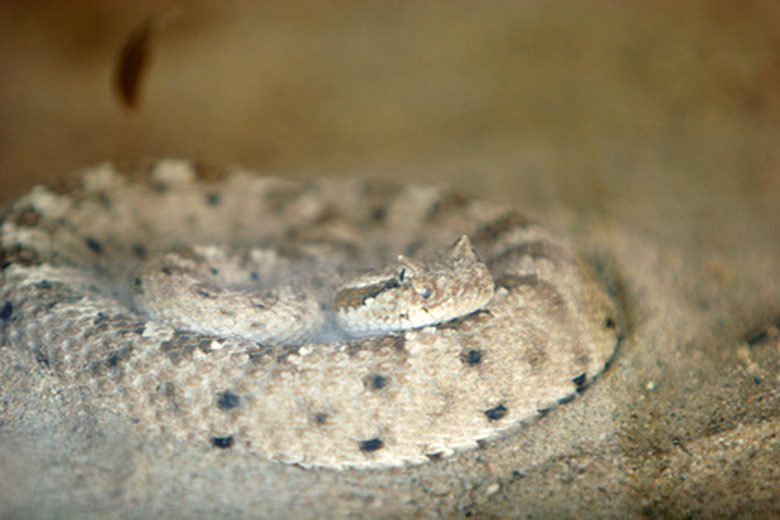Sidewinder Snake Facts
The sidewinder snake, Crotalus cerastes, belongs to the subfamily Crotalinae. These are also known as pit vipers, and the group includes rattlesnakes. Sidewinders have the typical attributes of other rattlesnakes, including a rattle, but they can be easily distinguished from them by the presence of large, hornlike structures above the eyes. Adults are small and typically only 1.5 to 2 feet long, but they are capable of growing to more than 2.5 feet in length.
Geography and Habitat
Geography and Habitat
Sidewinders are desert snakes, specifically, reptiles of the southwestern deserts of North America; they are restricted the southwestern U.S. and northwestern Mexico. In the U.S., sidewinders range from the lower, eastern half of California, through southern Nevada, to the southwestern tip of Utah and western Arizona. In Mexico, sidewinders can be found in eastern Baja California and western Sonora. Sidewinders favor deserts with loose, wind-blown sand at low elevations (below sea level to about 5,900 feet), especially if the sand is topped with vegetation such as the creosote bush. Other suitable desert habitats include areas with hardpan, gravel or rocky substrates.
Sidewinder Locomotion
Sidewinder Locomotion
The common name "sidewinder" alludes to this snake's distinguished style of sideways locomotion (side-winding), which it uses to gain traction while moving over loose sand. Side-winding involves moving the body sideways in a series of S-shaped curves, while only allowing a few points of the body to contact the hot sand each time. Sidewinders leave a distinguishable series of parallel J-shaped tracks, with the hooks of the "J"s pointing in the direction of travel.
Predation and Diet
Predation and Diet
Sidewinders are sit-and-wait predators that feed primarily on small rodents and lizards of the desert. Sidewinders ambush most of their prey outside the entrances of rodent and lizard burrows, where they wait partially buried (sometimes with only their head and back exposed) for the prey to emerge. Adults eat mostly small rodents and lizards, but will occasionally consume small birds and snakes. Neonates and small juveniles, on the other hand, feed almost exclusively on lizards.
Reproduction Cycle
Reproduction Cycle
Mating takes place in either the spring or fall, with most mothers giving birth to their young in August, September or October. Baby sidewinder litters that range in size from one to 20 offspring, with most litters containing seven to 12 babies. The average length of a baby sidewinder is about seven inches, and they weigh about six grams.
Predatory Threats
Predatory Threats
Although venomous, sidewinders–especially young ones–have numerous predators. Mammalian predators include kit foxes and coyotes, which can be abundant in some areas. Large predatory birds–kestrels, hawks, owls, roadrunners, ravens, shrikes and others–are also common predators of sidewinders. Sidewinders also fall prey to a number of reptile species, such as:
- leopard lizards
- coachwhip snakes
- rosy boas
- other
- larger sidewinders
References
- "Snakes of the United States and Canada"; Carl H. Ernst and Evelyn M. Ernst; 2003
- California Herps: Crotalus cerastes cerastes
Cite This Article
MLA
Writer, Contributing. "Sidewinder Snake Facts" sciencing.com, https://www.sciencing.com/sidewinder-snake-6550602/. 22 November 2019.
APA
Writer, Contributing. (2019, November 22). Sidewinder Snake Facts. sciencing.com. Retrieved from https://www.sciencing.com/sidewinder-snake-6550602/
Chicago
Writer, Contributing. Sidewinder Snake Facts last modified March 24, 2022. https://www.sciencing.com/sidewinder-snake-6550602/
